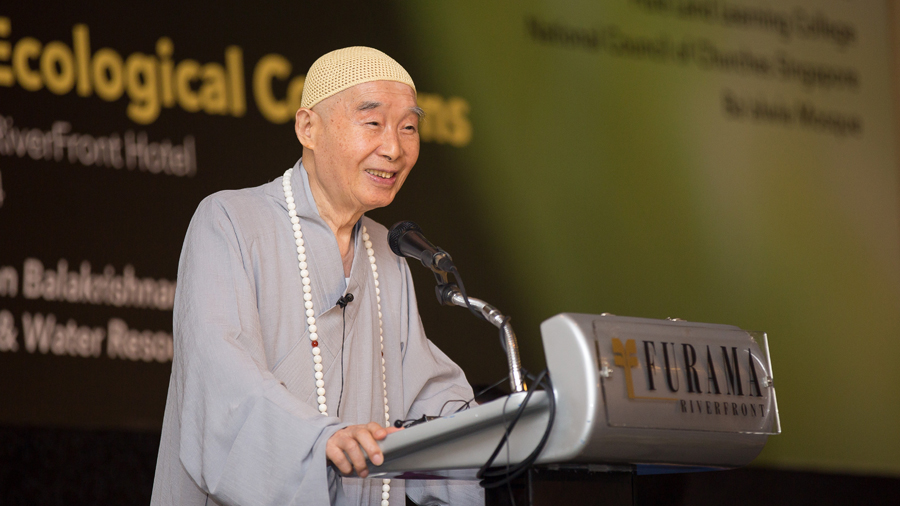Venerable Master Chin Kung presented a keynote address 2018.09.17
Your Excellency Ms Audrey Azoulay, Director-General of UNESCO, Your Excellency Mrs Zohour Alaoui, President of the General Conference of UNESCO, Your Excellency Mr Lee Byong-hyun, President of the Executive Board of UNESCO, Your Excellencies)、ladies and gentlemen.
I am honoured to be here with all of you today to have a discussion on the topic of intercultural and interreligious dialogues to promote world peace. Since 2006, we have been participating in the organization of events at UNESCO. It has been 12 years.
Today, I feel truly delighted to see many old friends and new faces gathering here to show their concern for this topic, which involves the destiny of all human beings.
Many insightful individuals have been working hard on the issue of intercultural and interreligious dialogues. However, some people question its effectiveness. Some think such dialogues are not effective because they cannot be put into practical actions. How do we enhance the efficiency of intercultural and interreligious dialogues so as to promote social harmony? This is what I would like to share with all of you.
“The four all-embracing methods” is the way I recommend. Since 1998, I have been promoting religious cohesion in Singapore. We were able to bring the nine major religions in Singapore together and in the end, they were like families. Our efforts were recognized by the Singapore government. A senior official asked me, “Our Inter-Religious Organization (IRO) have worked hard for 50 years without great success. How did you achieve it?” I told him that I used “the four all-embracing methods”.
In order to promote friendship and mutual understanding, people should have frequent interactions and communications. This way, all issues can be resolved. If there is no interaction, there will be more misunderstandings which will in turn worsen relationships. “The four all-embracing methods” is the way to promote interpersonal communication. I will show you how to utilize the four all-embracing methods by using our experience in Singapore as an example.
1. The practice of giving: This means to invite people more often and give more gifts. This will help to bridge and foster friendships. I took the initiative to visit all major religions in Singapore when I first arrived. I donated $100,000 Singapore dollars to each religion to support and sponsor their charity works. This sizable gift gained the attention from everyone. . And afterward, we had more opportunities to interact with one another. We often exchanged gifts and invited one others for meals which enriched our friendships.
2. Caring words: with sincerity, speak soft and gentle words that genuinely care for others and words that are happily accepted and welcomed. . Different religions should praise one another and avoid of criticizing one another. It is a taboo for religions to compete for believers. Therefore, we have to affirm that every religion is the best. There is no second best. No matter which religion one believes in, that is the best one. Religions should not convert other believers.
3. Beneficial deeds: Do what we can to benefit and help others. At one time, there was a religious school in Singapore, which needed to buy a piece of land because the landlord needed to sell the piece of land where the school was located. However, the amount needed exceeded the amount we could sponsor. Hence, we organized a joint charity auction with various religions. We even invited the local government officials to join the effort. At the end, the amount collected exceeded the amount of money needed. We donated all the proceeds to this religion. Their problem was resolved.
4. Work together: Everyone has a common goal and work together to achieve it. After religious cohesion was achieved among the nine major religions in Singapore, we have the common goal to promote religious harmony in the world. In 2006, during our celebration of the Vesak Day at the UNESCO, the representatives of the nine major religions from Singapore went onto the stage and joined hands to pray for world peace. Everyone attending the ceremony was moved by what transpired in the event.
We have always believed that the best way to bring different religions together is to organize travel tours. Once, I had accompanied the religious representatives from Singapore to visit China. The religious leaders are usually busy. It is not easy for them to meet with one another. Even when they do meet, most can only spare an hour or two, which makes it difficult for them to have in-depth communication. When they are travelling aboard as a group, everyone spends day and night together. There are plenty of opportunities for them to interact and learn from each other. One such trip, everyone becomes good friends with one another.
In 2001, I was invited by the minister of the Department of Immigration and Multicultural Affairs, Hon. Philip Ruddock, to immigrate to Australia to help the Australian government to bring together different religions and different ethnic groups. To accomplish these two tasks, we have been applying the four all-embracing methods in Toowoomba City of Queensland. For more than a decade, we have successfully brought together more than ten major religious groups together in Toowoomba. Recently, we have been reporting our work in Toowoomba at the UNESCO headquarters in Paris. Last year in March, nine ambassadors from UNESCO visited Toowoomba in person to experience the harmonious atmosphere there.
That is all that I would like to report to you. Hopefully, “the four all-embracing methods” can contribute to the efficiency of intercultural and interreligious dialogues and help to promote world peace, harmony and acceptance. Thank you!

